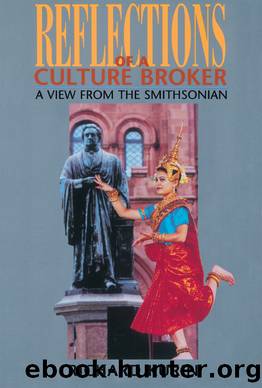Reflections of a Culture Broker by Richard Kurin

Author:Richard Kurin [Kurin, Richard]
Language: eng
Format: epub
ISBN: 978-1-935623-65-6
Publisher: Smithsonian
Published: 2014-12-10T00:00:00+00:00
Building the Mela! Smithsonian staff, including construction personnel, were inexperienced in working with bamboo, terra-cotta tile, coconut leaves, shÄmÄ«yÄnÄ, kanÄth (canvas applique canopies and walls), and other building materials sent from India. Production plans called for an Indian crew of carpenters and craftspeople who could work with the Smithsonian crew to build the âMela!â structures.
The tool kits, techniques, flexibility, and improvisation of the Indian carpenters confounded the Smithsonian labor crew, engineers, and carpenters, who valued mechanization, precision of measurement, standardization, and square-angle construction. After some days of mutual denial of each otherâs abilities, the American and Indian crews developed an appreciation of each otherâs craftâIndian carpenters experimented with power drills and augurs and Americans discovered the need for flexibility when dealing with bamboo and came to understand the rationale of interlocking terra-cotta tiles. Indian carpenters, communicating through their work, demonstrated the contingent nature of construction at an Indian melÄâbuilding around trees and roots and making use of materials at hand. Smithsonian personnel and contractors who idealized construction as a closed system of actualizing measured plans gained from these carpenters a new perspective on their own work. In the end, while Smithsonian engineers reworked stress equations on their calculators and puzzled as to why the structures stood at all, scores of American volunteers, including builders and roofers, came down to the Mall to help and to learn from the Indians.
In one instance, the difference between Indian and American standards could not be bridged. Our plan was to have coconut leaf roofs for some âMela!â stalls. Woven mats of coconut leaf fronds make for excellent roofing in India. It is a lightweight material and when it rains the soaked leaves mesh together, making the surface relatively impermeable. Since we often get summer thunderstorms during the festival on the National Mall, this type of roofing seemed ideal for conveying both the aesthetic and the utility of a traditional architectural form.
In order to bring the ton of dried coconut leaf fronds into the United States, we were required to have them fumigated in India, to prevent unintended importation of potentially harmful insects and parasites. Unfortunately, the fumigant made the coconut leaf more flammable than usualâas fire marshals from the District of Columbia discovered when they tested the in-place roofs two days before the festivalâs opening. The roofs constituted a fire hazard that had to be corrected. The Smithsonian spent $10,000 in fire retardant, and staff and volunteers worked through the night to dip and spray all the coconut leaf and reinstall the roofs. And then it rained. The roofs leaked. The fire retardant had coated each leaf with a plastic laminate that prevented the leaves from meshing together. We spent the next night installing plastic wrap under the coconut leaf.
In this case, the chain of actions and consequencesâIndian and Americanâdid not work out very well. Traditional architectural materials and ideas about their use were confounded by American practices and notions of safety. The interpenetration of functional perquisites from the two cultures was dysfunctional in
Download
This site does not store any files on its server. We only index and link to content provided by other sites. Please contact the content providers to delete copyright contents if any and email us, we'll remove relevant links or contents immediately.
Life 3.0: Being Human in the Age of Artificial Intelligence by Tegmark Max(5476)
The Sports Rules Book by Human Kinetics(4297)
The Age of Surveillance Capitalism by Shoshana Zuboff(4214)
ACT Math For Dummies by Zegarelli Mark(3996)
Unlabel: Selling You Without Selling Out by Marc Ecko(3591)
Blood, Sweat, and Pixels by Jason Schreier(3566)
Hidden Persuasion: 33 psychological influence techniques in advertising by Marc Andrews & Matthijs van Leeuwen & Rick van Baaren(3475)
The Pixar Touch by David A. Price(3369)
Bad Pharma by Ben Goldacre(3358)
Urban Outlaw by Magnus Walker(3342)
Project Animal Farm: An Accidental Journey into the Secret World of Farming and the Truth About Our Food by Sonia Faruqi(3178)
Kitchen confidential by Anthony Bourdain(3014)
Brotopia by Emily Chang(3002)
Slugfest by Reed Tucker(2944)
The Content Trap by Bharat Anand(2863)
The Airbnb Story by Leigh Gallagher(2800)
Coffee for One by KJ Fallon(2570)
Smuggler's Cove: Exotic Cocktails, Rum, and the Cult of Tiki by Martin Cate & Rebecca Cate(2474)
Beer is proof God loves us by Charles W. Bamforth(2375)
